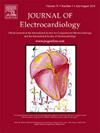Precordial swirl sign: A new ECG pattern of left anterior descending artery occlusion myocardial infarction
IF 1.3
4区 医学
Q3 CARDIAC & CARDIOVASCULAR SYSTEMS
引用次数: 0
Abstract
Objective
We sought to describe and evaluate an ECG pattern of left anterior descending (LAD) occlusion for which we have coined the term “precordial swirl.” In this pattern the ECG manifests abnormal ST elevation (STE) and/or hyperacute T waves in V1-V2, with reciprocal STD and/or TWI in V5-V6, creating a clockwise “swirl” pattern in the ST-T shifts of the precordial leads.
Methods
After deriving the characteristics of the precordial swirl pattern from 17 patients with proven acute LAD occlusion, the pattern was evaluated retrospectively using a high-risk population of ED patients with possible ACS symptoms. The primary outcome measures were positive predictive value and specificity for Occlusion MI for each of the developed criteria for precordial swirl sign.
Results
Several criteria were derived based on observations and measurements of the derivation cohort. The validation cohort consisted of 808 patients, of whom 265 had Occlusion MI. Precordial swirl pattern, defined as normal QRS (narrow QRS without LVH) with STD in V5 and/or V6 plus any STE in V1 and/or V2, yielded PPV 42 %, sensitivity 11 %, (95 % CI 8–15 %), and specificity 92 % (95 % CI 90–95 %) for Occlusion MI. When defined as a narrow QRS plus STD in V5/V6 plus T wave to S wave amplitude ratio > 0.40 in V2, precordial swirl pattern yielded PPV 70 %, sensitivity 9 %, specificity 98 %. Of the 23 Occlusion MI patients correctly identified by precordial swirl sign, 19 (83 %) had LAD culprit lesions, and 16 (70 %) were missed by STEMI criteria.
Conclusions
Among high-risk ACS patients in the ED, precordial swirl sign had clinically relevant PPV and specificity for LAD Occlusion MI, including a significant number of patients who are missed by the current STEMI criteria. Further study should be done to validate these findings and improve detection of acute coronary occlusion myocardial infarction.
心前旋征:左前降支闭塞性心肌梗死的一种新的心电图征象
目的:我们试图描述和评估左前降(LAD)闭塞的心电图模式,我们创造了术语“心前旋”。在这种模式下,心电图表现为V1-V2异常ST段抬高(STE)和/或超急性T波,在V5-V6表现为STD和/或TWI的互反,在心前导联的ST-T移位中形成顺时针“漩涡”模式。方法从17例经证实的急性前冠状动脉闭塞患者中得出心前旋流模式的特征后,对可能有ACS症状的ED患者的高危人群进行回顾性评估。主要结局指标是对闭塞性心肌梗死的阳性预测值和特异性。结果根据衍生队列的观察和测量得出了几个标准。验证队列包括808例患者,其中265例为闭塞性心肌梗死。心前旋流模式定义为正常QRS(窄QRS,无LVH), V5和/或V6有STD, V1和/或V2有任何STE,闭塞性心肌梗死的PPV为42%,敏感性为11% (95% CI 8 - 15%),特异性为92% (95% CI 90 - 95%)。0.40 V2,心前旋流模式PPV 70%,敏感性9%,特异性98%。在23例经心前旋征正确识别的闭塞性心肌梗死患者中,19例(83%)存在LAD罪魁祸首病变,16例(70%)未符合STEMI标准。结论在ED的高危ACS患者中,心前旋流征象具有临床相关的PPV和LAD闭塞性心肌梗死的特异性,包括大量被当前STEMI标准遗漏的患者。需要进一步的研究来验证这些发现,并提高对急性冠状动脉闭塞性心肌梗死的检测。
本文章由计算机程序翻译,如有差异,请以英文原文为准。
求助全文
约1分钟内获得全文
求助全文
来源期刊

Journal of electrocardiology
医学-心血管系统
CiteScore
2.70
自引率
7.70%
发文量
152
审稿时长
38 days
期刊介绍:
The Journal of Electrocardiology is devoted exclusively to clinical and experimental studies of the electrical activities of the heart. It seeks to contribute significantly to the accuracy of diagnosis and prognosis and the effective treatment, prevention, or delay of heart disease. Editorial contents include electrocardiography, vectorcardiography, arrhythmias, membrane action potential, cardiac pacing, monitoring defibrillation, instrumentation, drug effects, and computer applications.
 求助内容:
求助内容: 应助结果提醒方式:
应助结果提醒方式:


